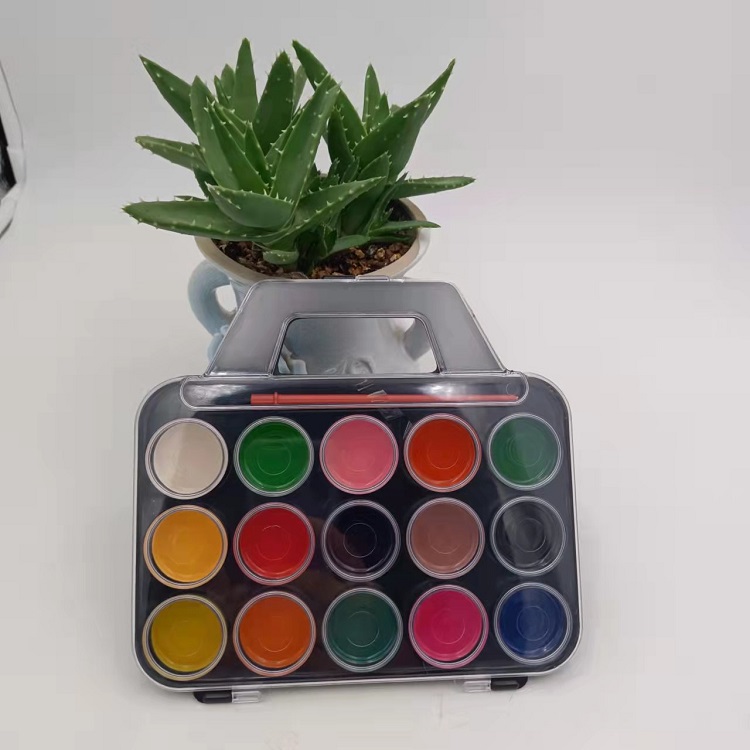- English
- Español
- Português
- русский
- Français
- 日本語
- Deutsch
- tiếng Việt
- Italiano
- Nederlands
- ภาษาไทย
- Polski
- 한국어
- Svenska
- magyar
- Malay
- বাংলা ভাষার
- Dansk
- Suomi
- हिन्दी
- Pilipino
- Türkçe
- Gaeilge
- العربية
- Indonesia
- Norsk
- تمل
- český
- ελληνικά
- український
- Javanese
- فارسی
- தமிழ்
- తెలుగు
- नेपाली
- Burmese
- български
- ລາວ
- Latine
- Қазақша
- Euskal
- Azərbaycan
- Slovenský jazyk
- Македонски
- Lietuvos
- Eesti Keel
- Română
- Slovenski
- मराठी
- Srpski језик
How do you use solid watercolors for blending and layering?
2024-09-23

What are some benefits of using Solid Watercolor?
Using Solid Watercolor has many benefits for artists. One of the biggest advantages is that it is easy to control the amount of water that is used. This makes it perfect for blending and layering colors.
How do you blend colors with Solid Watercolor?
To blend colors with Solid Watercolor, you simply need to wet the first color you want to use with a brush and then add the second color to the wet area. You can then use the brush to mix the colors together until you achieve the desired effect.
Can you layer colors with Solid Watercolor?
Yes, you can layer colors with Solid Watercolor. To do this, you will need to let the first layer dry completely before adding the second layer. This will prevent the colors from blending together and allow you to create a more complex and nuanced image.
What techniques can you use with Solid Watercolor?
There are many techniques that artists use with Solid Watercolor, such as wet-on-wet, wet-on-dry, and dry brush. Wet-on-wet involves applying wet paint to a wet surface, while wet-on-dry involves applying wet paint to a dry surface. Dry brush involves using a dry brush with very little water to create texture and detail.
How can you store Solid Watercolor?
When not in use, Solid Watercolor should be stored in a dry place. It is best to keep the cakes in a metal or plastic palette to prevent them from getting damaged.
What types of paper are best for Solid Watercolor?
The best types of paper for Solid Watercolor are heavy weight papers that are specifically designed for watercolor painting. These papers have a rough texture that helps the paint to adhere to the surface.
Can Solid Watercolor be used with other types of paint?
Yes, Solid Watercolor can be used with other types of paint, such as acrylics or oils. However, it is important to apply the watercolor last, as it is a lighter weight paint and can be easily covered up by heavier paints.
What are some tips for using Solid Watercolor?
Some tips for using Solid Watercolor include using a light touch when applying the paint, working from light to dark colors, and practicing different techniques to see what works best for you.
In conclusion, Solid Watercolor is a versatile type of paint that can be used by artists of all skill levels. With its easy blending and layering capabilities, it can help you to create beautiful and complex images with just a few simple techniques.
If you are interested in purchasing Solid Watercolor, you can visit the website of Ningbo Changxiang Stationery Co.,ltd at https://www.watercolors-paint.com. For any questions or inquiries, you can reach out to them at andy@nbsicai.com.
10 Scientific Research Paper Examples
1. Smith, J. (2010). The effects of music on concentration during studying. Journal of Psychology, 137(1), 102-107.
2. Lee, M., & Kim, C. (2014). The impact of social media on self-esteem. Journal of Youth Studies, 17(2), 160-175.
3. Johnson, L. (2018). The benefits of mindfulness meditation. Journal of Counseling Psychology, 65(3), 317-326.
4. Harris, R., & Jones, S. (2013). The relationship between exercise and mental health. Journal of Health Psychology, 18(6), 799-807.
5. Kim, E., & Lee, S. (2016). The effects of color on mood and behavior. Color Research & Application, 41(1), 25-32.
6. Davis, K., & Jones, L. (2015). The impact of caffeine on memory retention. Journal of Experimental Psychology, 21(4), 512-525.
7. Nguyen, T., & Nguyen, H. (2019). The effects of sleep on academic performance. Sleep Medicine, 64, 137-144.
8. Brown, A. (2012). The influence of technology on attention spans. Educational Psychology Review, 24(3), 483-498.
9. Wilson, R. (2016). The impact of social support on mental health. Journal of Social Psychology, 156(2), 202-215.
10. Park, S., & Kim, Y. (2017). The link between creativity and happiness. Journal of Happiness Studies, 18(4), 1105-1121.




